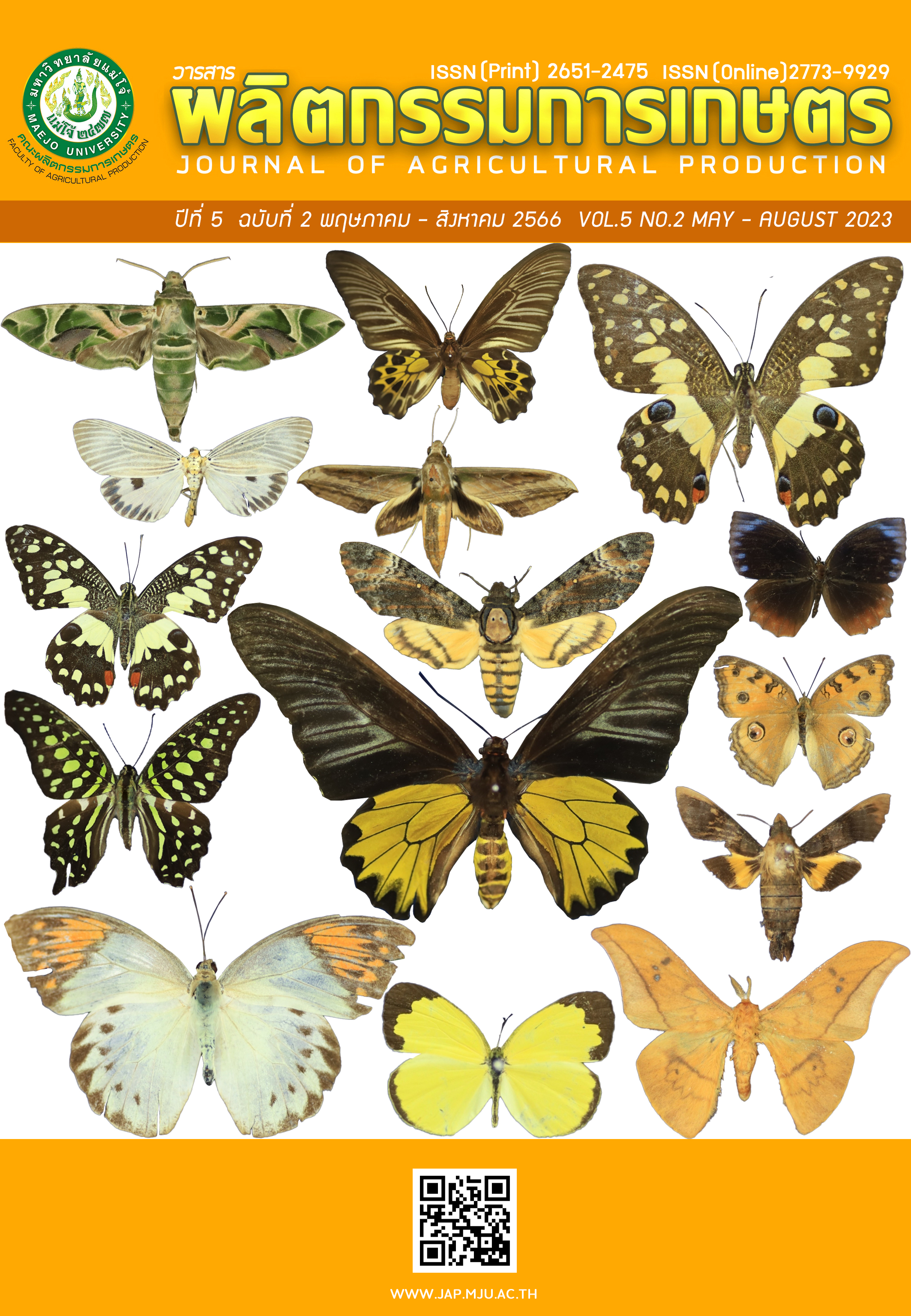การประเมินความสัมพันธ์ขององค์ประกอบและคุณภาพผลผลิตของหม่อนผลพันธุ์ผสมเปิด
Main Article Content
บทคัดย่อ
งานวิจัยนี้มีวัตถุประสงค์เพื่อประเมินความสัมพันธ์ของลักษณะที่แสดงออกของหม่อนผลพันธุ์ผสมเปิดที่ได้จากการคัดเลือก 6 สายพันธุ์ เปรียบเทียบกับพันธุ์เชียงใหม่ ผลการศึกษาพบว่าสายพันธุ์ 1037 และ 1102 มีลักษณะความยาวกิ่ง (312.60 และ 295.56 ซม.) ผลผลิตรวมต่อต้น (2,127.00 และ 1,536.30 ก.) TSS/TA (47.13 และ 47.48) และปริมาณสารประกอบฟีนอลิกทั้งหมด (1,243.60 และ 1,214.00 มก. สมมูลของกรดแกลลิคต่อ 100 ก. น้ำหนักแห้ง) มากกว่าพันธุ์เชียงใหม่ ปริมาณของแข็งที่ละลายได้ (TSS) อยู่ในช่วง 13.67-20.83 องศาบริกซ์ สัดส่วนปริมาณของแข็งที่ละลายได้ต่อปริมาณกรดที่สามารถไทเทรตได้ (TSS/TA) อยู่ในช่วง 21.27-47.48 ค่าสหสัมพันธ์ระหว่างลักษณะจำนวน 14 ลักษณะ พบว่า น้ำหนักผลผลิตรวมมีความค่าสัมประสิทธิ์ของสหสัมพันธ์ทางบวกอย่างมีนัยสำคัญทางสถิติกับ น้ำหนักผล (r = 0.73) ความกว้างผล (0.59) และ ความยาวผล (0.61) ส่วนจำนวนกิ่ง น้ำหนักต่อผล ความกว้างผล ความยาวผล และผลผลิตต่อต้น มีความสัมพันธ์ทางบวกกับปริมาณของแข็งที่ละลายได้ (TSS) (0.87, 0.82, 0.87, 0.88 และ 0.62 ตามลำดับ) นอกจากนั้น สายพันธุ์ 1037 และ 1102 ซึ่งมีผลผลิตรวมต่อต้น และ TSS/TA สูง แสดงถึงศักยภาพเหมาะสมต่อตลาดหม่อนผลสด ข้อมูลที่ได้จากการศึกษาครั้งนี้สามารถนำไปใช้ในการคัดเลือกและพัฒนาสายพันธุ์หม่อนผลสดให้เหมาะสมต่อพื้นที่ปลูกในจังหวัดสกลนครได้
Article Details

อนุญาตภายใต้เงื่อนไข Creative Commons Attribution-NonCommercial-NoDerivatives 4.0 International License.
เอกสารอ้างอิง
ศูนย์หม่อนไหมเฉลิมพระเกียรติฯ เชียงใหม่. 2550. หม่อนพันธุ์แนะนำ: หม่อนผลสดพันธุ์เชียงใหม่. แหล่งข้อมูล http://chiangmaisilk.blogspot.com/2007/07/blog-post_2391.html (2 สิงหาคม 2565).
A.O.A.C. 1990. Official Methods of Analysis. 15th Edition, Association of Official Analytical Chemist, Washington DC.
Ebrahimi, A., A. Poursalavati, M.M. Esboei, S.R. Monfared, M. Sahebi, M.R. Amerian and H.H. Khoshro. 2021. Population and individual multivariate analysis of white (Morus alba), red (Morus rubra) and black (Morus nigra) mulberry genotypes: applications for breeding, conservation and development. Euphytica. 217: 1-27.
Ercisli, S. and E. Orhan. 2007. Chemical composition of white (Morus alba), red (Morus rubra) and black (Morus nigra) mulberry fruits. Food chem. 103(4): 1380-1384.
Gundogdu, M., F. Muradoglu, R.G. Sensoy and H. Yilmaz. 2011. Determination of fruit chemical properties of Morus nigra L., Morus alba L. and Morus rubra L. by HPLC. Sci. Hortic. 132: 37-41.
Han, S.Y. 2007. The ecological value of mulberry and its ecological cultivation models for planting mulberry from eastern to western areas in Guizhou. Guizhou Agric. Sci. 35(5): 140-142.
Hashemi, S. and A. Khadiv. 2020. Morphological and pomological characteristics of white mulberry (Morus alba L.) accessions. Sci. Hortic. 259: 1-9.
Hosseini, A.S., M. Akramian, A. Khadivi and H. Salehi-Arjmand. 2018. Phenotypic and chemical variation of black mulberry (Morus nigra) genotypes. Biol. Ind. Crop. Prod. 117: 260-271.
Huang, F. and D. Wang. 2012. The introduction to mulberry to ecological restoration. North Sericulture. 33(4): 52-54.
Iqbal, S., U. Younas, K.W. Chan, R.A. Sarfraz and M.K. Uddin. 2012. Proximate composition and antioxidant potential of leaves from three varieties of Mulberry (Morus sp.): a comparative study. Int. J. Mol. Sci. 13(6): 6651-6664.
Jeszka-Skowron, M., E. Flaczyk, J. Jeszka, Z. Krejpcio, E. Król and M.S. Buchowski. 2014. Mulberry leaf extract intake reduces hyperglycaemia in streptozotocin (STZ)-induced diabetic rats fed high-fat diet. J. Funct. Foods. 8: 9-17.
Jiang, Y. and W.J. Nei. 2015. Chemical properties in fruits of mulberry species from the Xinjiang province of China. Food Chem. 174: 460-466.
Johnson, R. and P. Kuby. 2004. Elementary Statistics, Thomson Learning, Inc., USA.
Juan, C., K. Jianquan, T. Junni, C. Zijian and L. Ji. 2012. The profile in polyphenols and volatile compounds in alcoholic beverages from different cultivars of mulberry. J. Food Sci. 77(4). 430-436.
Krishna, H., D. Singh, R.S. Singh, L. Kumar and B.D. Sharma. 2020. Morphological and antioxidant characteristics of mulberry (Morus spp.). J. Saudi Soc. Agric. Sci. 19: 136-145.
Nonthakod, S., P. Wiwacharn, C. Sangsiri and T. Kajonphol. 2019. Correlation and path coefficient for economic traits of fruit mulberry (Morus spp.) based on criteria mulberry selection. Appl. Mech. Mater. 891: 66-70.
Peris, N.W., K.M. Gacheri, M.M. Theophillus and N. Lucas. 2014. Morphological characterization of mulberry (Morus spp.) accessions grown in Kenya. Sustain. Agric. Res. 3(1): 10-17.
Rahman, S.M. and S.S. Islam. 2020. Genetic variability and correlation studies of mulberry (Morus alba L.) genotypes in Bangladesh. Bangladesh J. Bot. 49(3): 685-691.
Srivastava, S., R. Kapoor, A. Thathola and R.P. Srivastava. 2003. Mulberry (Morus alba) leaves as human food: a new dimension of sericulture. Int. J. Food Sci. Nutr. 54(6). 411-416.
Thriveni, M.C., R. Mondal, G. Thanavendan, G. Ravikumar and B.T. Sreenivasa. 2021. Characterization of mulberry genetic resources for multiple traits. IJAB. 1(2): 8-15.
Vijayan, K. 2010. The emerging role of genomic tools in mulberry (Morus) genetic improvement. Tree Genet. Genomes. 6(4): 613-625.
Wang, Y., L. Xiang, C. Wang, C. Tang and X. He. 2013. Antidiabetic and antioxidant effects and phytochemicals of mulberry fruit (Morus alba L.) polyphenol enhanced extract. PloS one. 8(7): 1-10.
Wu, C.H., S.C. Chen, T.T. Ou, C.C. Chyau, Y.C. Chang and C.J. Wang. 2013. Mulberry leaf polyphenol extracts reduced hepatic lipid accumulation involving regulation of adenosine monophosphate activated protein kinase and lipogenic enzymes. J. Funct. Foods. 5(4). 1620-1632.
Yilmaz, K.U., Y. Zengin, S. Ercisli, M.N. Demirtas, T. Kan and A.R. Nazli. 2012. Morphological diversity on fruit characteristics among some selected mulberry genotypes from Turkey. J. Animal Plant Sci. 22(1): 211-214.


